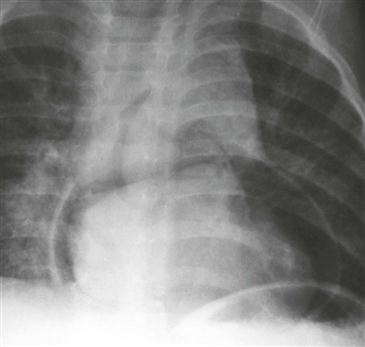CASE 95

1. What etiologies can cause this finding? (Choose all that apply.)
A. Trauma
C. Barotrauma
2. What is the most common cause of this finding in infants?
A. Trauma
C. Barotrauma
3. Which of the following is not a cause of this finding in the setting of a malignant neoplasm?
4. How can barotrauma result in pneumopericardium?
A. Interstitial air dissects along the pulmonary vessels.
B. Pneumothorax occurs and communicates with the pericardium.
C. Pneumomediastinum occurs and communicates with the pericardium.
ANSWERS
References
Katabathina VS, Restrepo CS, Martinez-Jimenez S, et al. Nonvascular, nontraumatic mediastinal emergencies in adults: a comprehensive review of imaging findings. Radiographics. 2011;31(4):1141–1160.
Trotman-Dickenson B. Radiology in the intensive care unit (part 2). J Intensive Care Med. 2003;18(5):239–252.
Comment
Etiology
Pneumopericardium is most commonly posttraumatic or iatrogenic. After pericardiocentesis, a small amount of air is frequently seen in the pericardium, but a large pneumopericardium is unusual. Barotrauma-induced pneumopericardium is most frequently seen in children and infants. In infants, barotrauma can result in a large pneumopericardium. Barotrauma causes alveolar rupture. Air dissects medially along the pulmonary vessels and bronchi towards the mediastinum. It most frequently causes pneumomediastinum but may also lead to pneumopericardium. In this setting, the pneumopericardium is usually self-limiting and resolves spontaneously. Rarely, an esophageal-pericardial fistula can develop, sometimes secondary to a malignant tumor. In this setting, patients may have a hydropneumopericardium.
Imaging
Radiography and CT can show air in the pericardial space (Figure). Tension pneumopericardium is a life-threatening condition diagnosed in the setting of hemodynamic collapse. Imaging findings on CT or MRI which suggest tamponade physiology include compression of the anterior aspect of the heart, dilated inferior vena cava, and compression or displacement of cardiac chambers. Immediate pericardial decompression is required in patients with cardiac tamponade to prevent death.







